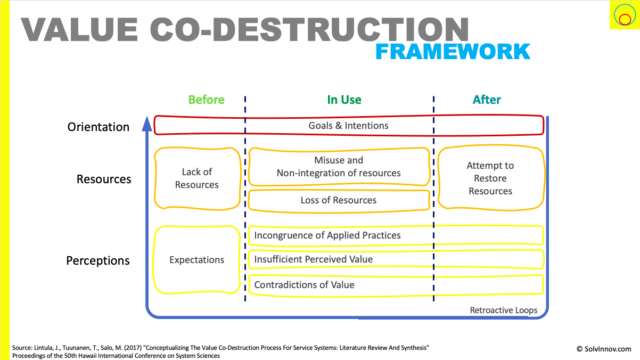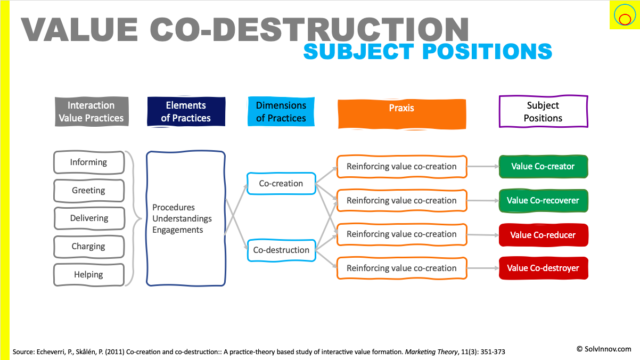The Big Picture…
Value co-creation – where actors are seen as working together to co-create value – is a distinguishing aspect of service-dominant logic. And adopting that is part of the solution to the innovation problem.
But where there is co-creation there is co-destruction. And that is defined as when interactions between actors result in a decline in at least one of the actors’ well-being (Plé and Cácares (2010)).
At a high level, it comes about when one or more actors misuses their own or other resources, either accidentally, or intentionally. But there are subtleties in this, which Lintula et al (2017) pull out in their framework below.
They say that value co-destruction comes from a variety of components spread over time (before, in-use, and after service provision). And can be grouped into 3 dimensions:
- orientation – goals and intentions
- resources – lack, misuse, non-integration, and loss of resources. As well as when an impacted party tries to recover loss (e.g. posting a bad review online of service delivery)
- perceptions – expectations, the incongruence of applied practices (different views), insufficient perceived value and contradictions in value for a party.
Each actor can take one of several positions (Echeverri and Skålén). They can be a:
- co-creator
- co-recoverer
- co-reducer or
- co-destroyer of value.
Implications
Think of bad hotel service, misunderstandings in Agile software delivery, imposing self-service, abusing review platforms, or even the last experience you had with an AI chatbot. In those, and more, we need to understand not just where value is co-created, but how it can be co-destroyed. And we must act to minimise the opportunity for co-destruction and increase the opportunity for co-recovery of value.
The Idea
Much is made in service-dominant logic about value being co-created (in-use):
Value is co-created by multiple actors, always including the beneficiary
Axiom 2 / Foundational Premise #6 of Service Dominant Logic
And we see this happening through interactions between actor generated institutions (individuals or organisations):
Value co-creation is coordinated through actor-generated institutions and institutional arrangements
Axiom 5 / Foundational Premise #11 of Service Dominant Logic
Service – and everything is a service – happens as actors integrate their resources. The only purpose of a service is to help the beneficiary make progress with some aspect of their life. And that progress can be functional and/or non-functional.
We see value as having two components. A proposed value, in which a value proposition proposes how it will help a beneficiary make progress. And an achieved value – the amount of progress the beneficiary (and only the beneficiary) determines they have made.
That achieved value is co-created during the use of the service. And expectations are set by the proposed value of the value proposition.
However, value can be co-destructed – a topic that does not have as much visibility as co-creation.
What is value co-destruction?
Not all interactions reach the desired or positive outcome (Prahalad and Ramaswamy (2004)). And, they may even lead to negative value (Grönroos (2008)). And where value can be co-created, Plé & Cáceres claim – not unreasonably – it also can be co-destructed. In “Not Always Co-Creation: Introducing Interactional Co-Destruction Of Value In Service-Dominant Logic” they define value co-destruction as:
an interactional process between service systems that results in a decline in at least one of the systems’ well-being
Plé, L., Cáceres, R. (2010)
In general, if two service systems (actors) are interacting, then either of them could misuse their own or the other’s resources, either accidentally or intentionally, leading to value co-destruction. And that value co-destruction can be for all or just one of the actors involved (Plé, 2017).
Let’s jump to some better examples!
Bad service Experience
Not all interactions between firms and customers are enjoyed. Nor are they all perceived in a positive manner by the customer (Prahalad and Ramaswamy). I think we’ve all experienced this guy at some point:
Here the hotelier is misusing his own resource (himself) to create poor interactions with hotel guests. His behaviour leads guests to behave differently to him; which cyclically leads to worse behaviour. Value is co-destroyed.
Abuse of Review Platforms
TrustPilot, Air B’n’B, Uber, Yelp, Amazon, TripAdvisor and more offer the ability for people to leave reviews on a variety of services.
The value co-creation potential of such sites is three-fold. Firstly, on one side of the platform, is the actor that offers the value proposition. Better reviews by beneficiaries should lead to more custom. On the other side of the platform is the potential beneficiary (customer). Truthful reviews help them make decisions. And thirdly the platform itself benefits. With more usage comes more eyes, and more eyes mean popularity which means even more eyes. And eyes often translates to advertising revenue.
Yet it is easy for customers, even fake customers, to leave malicious untrue reviews – a misuse of the platform resource. Now the value is destroyed for the actor offering the proposition. And the value is destroyed for other customers as they may decline great offers. Ultimately value may be destroyed for the platform if both parties start to distrust it.
Agile Software Development
Developing software in an Agile manner offers many promises. Not least flexibility and a focus on the early generation of business value. Both the business and software development team work together co-creating value. Guided by four principles:
- Individuals and Interactions Over Processes and Tools
- Working Software Over Comprehensive Documentation
- Customer Collaboration Over Contract Negotiation
- Responding to Change Over Following a Plan
But if either party does not understand the agreed ways of working then they quickly start misusing the other party’s resources. For example, often contracts are not fixed price and the scope should be flexible. But in my experience whilst clients say they want this, they get agitated when scope or price has to flex. Value is quickly co-destroyed.
Co-innovation
Open Innovation is an example of where there is potential value co-creation. Firms publish challenges and look to outsiders to submit ideas. Interesting ideas are discussed further; with the expectation that some of those interactions lead to new products/ways of working, i.e. co-creation of value.
However, as Plé & Cáceres note, there is a challenge. Let’s say your open innovation looks to customers for ideas. Customers have limited knowledge of the technologies available. And so are not best placed to predict which innovations are best to chase or able to envisage how innovations would be used. As such, customers are unable to use their or the firm’s resources in the best way.
Value co-destruction comes about as the firm becomes less competitive by being distracted into chasing ultimately wrong innovations. And for the customer, they can feel they are wasting time they could spend elsewhere and risk getting frustrated with the firm.
Imposing Self-service
Plé & Cáceres also list an example of firms shifting interactions to an automated self-service approach. This is not uncommon today with self-service in supermarkets. However, the willingness of customers to adopt self-service is variable (perhaps due to innovation resistance and perhaps that they determine value phenomenologically).
When a firm imposes self-service technology on customers, those customers can see this as a misuse of the firm’s resources to adversely impact their well-being.
AI Chatbots
Castillo, Canhoto and Said delve into artificial intelligent chatbots – those that replace front line employees. There are five aspects that could lead to value co-destruction from a customer perspective:
- Feeling deceived about whether they are dealing with a real human or a bot (authenticity)
- Frustration when chatbots are not understanding the enquiry (cognition)
- Expecting, but not receiving, a level of empathy a human often provides (affective)
- Finding that the chatbot is limited in what it can handle (functionality)
- Discovering that chatbot interactions are not stored/passed over to other communication channels (integration conflicts)
Luckily, there is a framework allowing us to see where value co-destruction can pop up.
Framework for value co-destruction
Plé & Cáceres paper defined co-destruction in terms of accidental or intentional misuse of resource. But that turns out to be too simplistic.
Lintula, Tuunanen, & Salo’s paper “Conceptualizing The Value Co-Destruction Process For Service Systems: Literature Review And Synthesis“. surveyed the literature. From that, they developed a framework to understand value co-destruction.
And their framework identified three components leading to value co-destruction (Figure 2). These are orientation, resources and perceptions. They also identified these components arise at different times: before, during, or after the service process.
Let’s look at these dimensions and components in turn.
Orientation in value co-destruction
Goals and Intentions
What are the goals and intentions of each actor in the interactions?
In “Co-Creation And Co-Destruction:: A Practice-Theory Based Study Of Interactive Value Formation“, Echeverri and Skålén take a practice-based view. They identify four positions an actor can take. They can be value co-creators or co-recoverers. Or they can be value co-reducers or value co-destroyers. These positions come from how they interpret the procedures, understandings and engagements in five interaction value practices – informing, greeting, delivering, charging and helping.
I look at this more in this article [link to come].
Resources role in value co-destruction
We know that service is the coordination of resources for the benefit of others or the entity itself. And that those resources come from the beneficiary as well as other actors involved.
Plé, in “Studying customers’ resource integration by service employees in interactional value co-creation” investigated what beneficiary resources are potentially used in value co-creation. And identified those in Figure 4.
Other actor resources could be those we take from Grönroos’ definition of service: the employees, physical resources, systems or goods of the service provider.
Then we can follow the flow of Lintula’s framework to see where is the potential for co-destruction:
- Before: Lack of resources
- During: Misuse and non-integration of resources; Loss of resources
- After: Attempt to restore resources
Lack of Resources
If any actor lacks resources before the service provision then there is potential for value co-destruction. Examples of resources, from Figure 4, are:
- time and or skills
- information being provided
- communications
- knowledge
Our example above of public open innovation is an example of lack of knowledge, usually on the side of the public. This is both in their general knowledge but it is also likely the firm will not provide enough information.
And Lintula et al summarise Robertson et al’s online medical diagnosis example (from “Are my symptoms serious Dr Google? A resource-based typology of value co-destruction in online self-diagnosis“).
value was co-destructed by both the provider and the user due to initial lack of resources. Consumer …often couldn’t comprehend the provided information due to lack of resources, such as sufficient medical knowledge, and secondly, providers often lacked resources to provide users with complete and understandable information. Due to initial lack of such resources, false and incomprehensible self-diagnoses occurred with a negative impact on customers’ well-being, and thus, value was co- destructed in the interactions [34].
Lintula, Tuunanen, & Salo (2017) Conceptualizing The Value Co-Destruction Process For Service Systems: Literature Review And Synthesis
Once the service starts there is potential for misuse, non-integration, and loss of resource.
Misuse and non-integration of resources
We’ve already seen the Plé and Cáceres originally definition of value co- destruction. That it comes from the accidental or intentional misuse of resources during the interaction process between service systems. And that the misuse could be of own and/or other actor’s involved resources.
Lintula et al add to this misuse, the non-integration of resources. Here one of more actors decide not to integrate their resources.
We can see this in the agile software development example. When the business do not follow the expected ways of working, they are non-integrating their resources. And that leads to value co-destruction as the Agile approach cannot be used. So business does not achieve the value expected. Not to mention the loss of morale in the development team.
Loss of Resources
Another potential cause of value destruction pops up if we have an unexpected loss of resources when the service is occurring. At best, value co-creation is hampered. And if the loss is too much to handle, and not replaced quick enough, then value co-destruction occurs.
Lintula et al point to Smith’s work on “The Value co-destruction process: a customer resource perspective” who states:
From the customer point of view, loss of resources (value co-destruction) would occur in four scenarios:
Smith (2013) The Value co-destruction process: a customer resource perspective
1) the provider is unexpectedly not able to fulfil the expected resource offer
2) expected resources are not gained
3) customer loses more resources than expected or
4) “A combination of the above”
After the service has ended, parties may attempt to restore resources they have lost during provision.
Attempt to Restore Resources
This, to me, is a little misleading. We are not talking about trying to restore lost resource during the service – for example adding replacement employees. Rather Lintula et al refer to the negative actions an impacted actor may take due to a perceived loss of resource in the other party. This may lead to a secondary value co-destruction for one or more parties.
Lintula point to a consumer that orders from an online food delivery service. And that delivery is late. The consumer experiences loss of resources (time, perhaps money etc). In response, the consumer publicly complains on Twitter etc. Now the service may suffer secondary loss, such as reputation.
Interestingly:
Employees’ integration of customers’ resource(s) in interactions is a dynamic process that may initially generate value co-creation (co-destruction) before it eventually results in value co-destruction (co-creation)
Plé Studying customers’ resource integration by service employees in interactional value co-creation
Which means that initial value co-destruction may turn to value co-creation through interactions, and vice-versa. We’ve all heard of examples where bad experiences highlighted on social media have been turned around by savvy responses from the firm.
Finally, let’s take a look at the third aspect: perceptions.
Perceptions leading to value co-destruction
Remember that value comes in two parts – the proposed and achieved value. When we “hire” a service we do so with a set of perceptions. Most often those are directly from the value proposition offered. Or they are inferred from other experiences we have had (either with the actor offering the value proposition, or in general).
When those perceptions are not met, we may see value co-destruction. Before the service starts we have expectations. And during/after the service we might find insufficient value co-generated, incongruence of practices or contradiction of values.
Expectations
Lintuna et al find three ways expectations can lead to value co-destruction.
Firstly, when expectations of service are not met by all parties involved then value co-creation is not achieved. And so value co-destruction can be inferred.
They further note that if one party’s expectations are not met, then that may lead to their intentional misbehaviour. Think again of our dissatisfied on-line food deliver service leaving a scathing review.
Finally, resources may be used or integrated in an unexpected or inappropriate way, leading to the concept of value destruction-through-misuse (the opposite of value-in-use).
Insufficient Perceived Value
We expect to achieve value aligned with the proposed value. That is to say the service will help us make progress as we expected (or better). When we don’t make that progress then we identify insufficient perceived value. And that leads to value co-destruction.
We have to remember that value is uniquely determined by the beneficiary. And that it is determined phenomenologically.
The ability of the provider to measure value the beneficiary is determining and alter course is useful.
Incongruence of Practices
If we jump back to Echeverri and Skålén’s practice-based view of service delivery (in “Co-Creation And Co-Destruction:: A Practice-Theory Based Study Of Interactive Value Formation“) we find that value co-destruction can arise when actors have differing views of any of the procedures, understandings and engagements.
They highlight, for example, someone running to catch a bus at a bus stop, which pulls off before the person gets there. In the eyes of travellers this can be seen as a negative – why didn’t you wait for her as you saw her running. But the driver might be following procedures related to the traffic light system they will miss if they have already activated the “let me through, I’m a bus” button.
Contradiction of values
Lintula et al (2018) define contradiction of values as follows in their investigation of Augmented Reality mobile games:
value is co-created for a user while a different value is co-destroyed during or after the use of the service
Lintula et al (2018) “When Value Co-Creation Turns to Co-Destruction: Users’ Experiences of Augmented Reality Mobile Games“
And they give as an example value contradictions “playing the game was fun, but it took her away from her young child, which made her feel like a bad parent”. “Wanting to take care of responsibilities”, “Luck defines success too much”,”Play takes time from other things in life”,”Playing excludes others”,”Setting a bad example for kids”
Vartiainen and Tuunanen (2014) looked at value contradictions in geocaching and identified the following contradictions: “i) an open secret society exists; ii) hedonism-seeking undermines hedonistic experiences; iii) one can experience nature while consuming it; and iv) building community occurs with competition.“
Wrapping Up
Similar to innovation resistance, value co-destruction is often not considered or addressed. Yet both can cause innovation to fail.
Plé and Cácares give us a helpful definition of value co-destruction. And Lintula et al give us a framework to understand where this co-destruction can take place. Allowing us to minimise and address.




